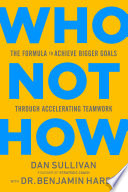

The central premise of 'Who Not How' is the power of collaboration. Instead of focusing on how to accomplish tasks and goals, the author emphasizes finding the right people (the 'who') to help you achieve those goals. This shift in mindset allows individuals to leverage the strengths and expertise of others, leading to more efficient and effective outcomes. Collaboration can take many forms, from partnerships and hiring to networking and mentorship. By surrounding yourself with the right people, you can multiply your efforts and achieve results that would be impossible to reach alone. This idea encourages readers to assess their goals and identify who can help them rather than getting bogged down in the minutiae of how to do everything themselves.
Continue readingThe book advocates for a mindset shift from scarcity to abundance. The scarcity mindset focuses on limitations and the belief that resources are finite, leading individuals to hoard knowledge and skills. In contrast, an abundance mindset recognizes that sharing knowledge and collaborating with others can lead to greater opportunities and success for everyone involved. This idea encourages readers to embrace the idea that there are enough resources, ideas, and opportunities for all. By adopting an abundance mindset, individuals can open themselves up to new possibilities and collaborations that can propel them towards their goals.
Continue readingA significant theme in 'Who Not How' is the importance of delegation and empowerment. Many individuals struggle with the idea of letting go of control and delegating tasks to others. However, the book argues that effective delegation is crucial for scaling success. By empowering others to take on responsibilities, individuals can focus on their strengths and high-value activities. This not only improves productivity but also fosters a sense of ownership and accountability among team members. The author provides practical strategies for effective delegation, emphasizing the need to communicate clearly, set expectations, and trust the capabilities of others.
Continue readingThe book encourages readers to identify their unique abilities and strengths. Understanding what you excel at allows you to focus on those areas while seeking out others to complement your skills. This idea is rooted in the belief that everyone has unique talents that, when harnessed effectively, can lead to greater success. The author provides exercises and prompts to help readers uncover their unique abilities, which can then inform their decisions about who to collaborate with and how to structure their work. By focusing on unique abilities, individuals can create a more fulfilling and impactful career.
Continue readingThe importance of building a supportive network is another key idea in 'Who Not How.' The author emphasizes that success is rarely achieved in isolation; instead, it is built on relationships and connections. A supportive network can provide guidance, resources, and opportunities that can significantly enhance your journey. The book offers insights into how to cultivate meaningful relationships, network effectively, and create a community of support. It also highlights the importance of giving back and supporting others in your network, creating a cycle of collaboration and mutual benefit.
Continue readingMentorship plays a crucial role in personal and professional development, as discussed in 'Who Not How.' The author highlights the value of seeking out mentors who can provide guidance, share their experiences, and help you navigate challenges. Mentors can offer a different perspective and help you identify opportunities that you may not have considered. The book also encourages readers to be mentors themselves, as teaching and guiding others can reinforce your own knowledge and skills. This reciprocal relationship can lead to exponential growth for both parties involved.
Continue readingFinally, 'Who Not How' emphasizes the importance of creating a clear vision for collaboration. Having a defined vision helps to align efforts and ensure that everyone involved is working towards the same goals. The author suggests that individuals should take the time to articulate their vision and communicate it effectively to potential collaborators. This clarity not only attracts the right people but also fosters a sense of purpose and motivation within the team. The book provides frameworks for developing and sharing your vision, making it an essential tool for successful collaboration.
Continue reading